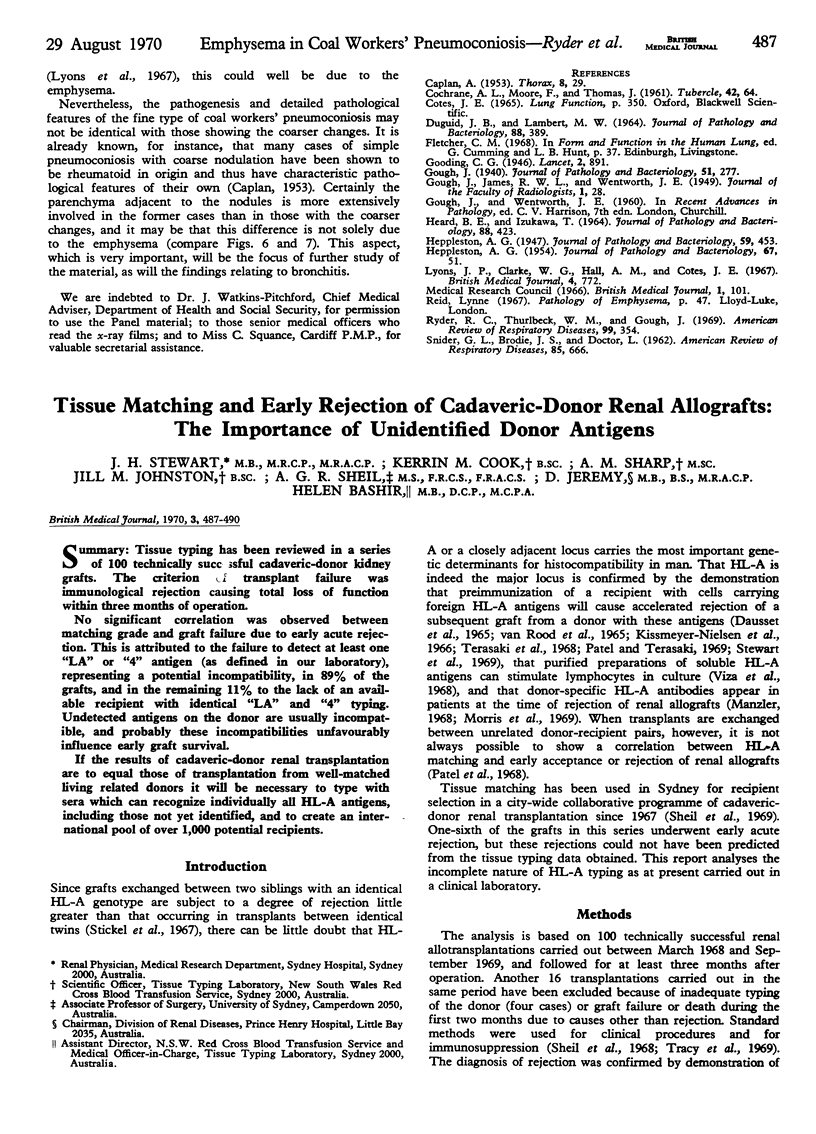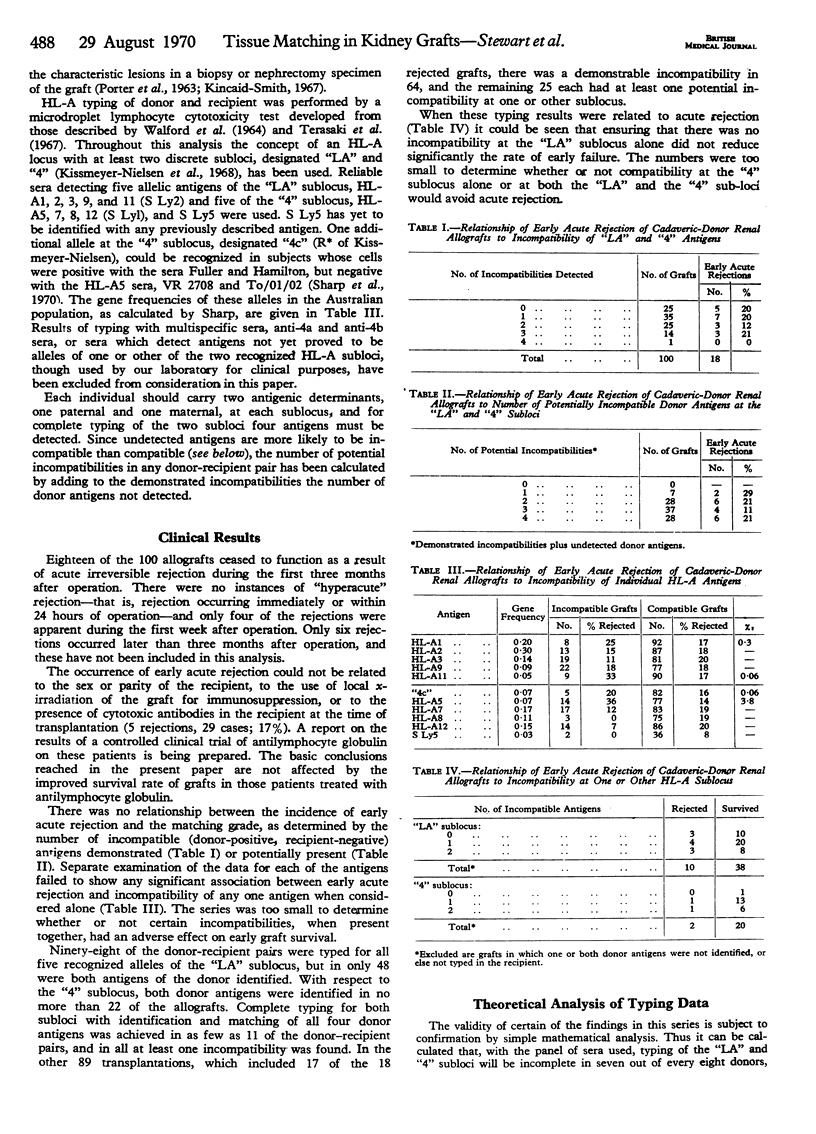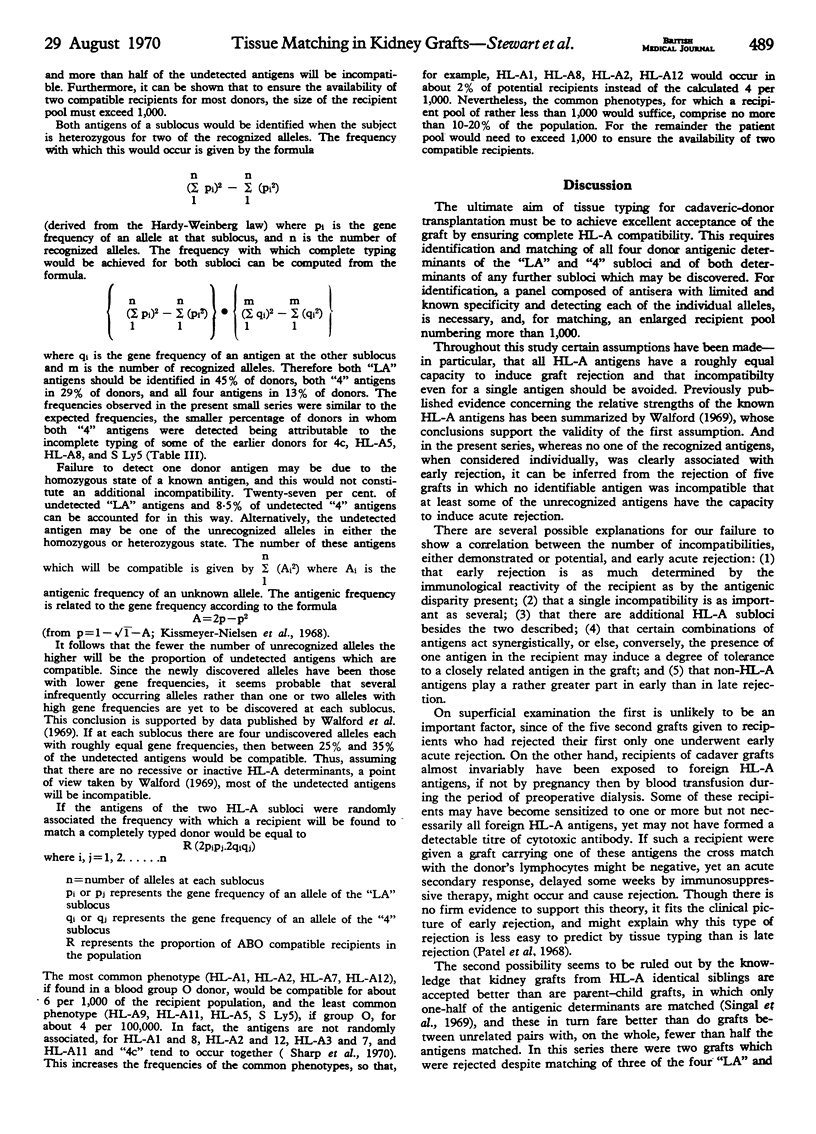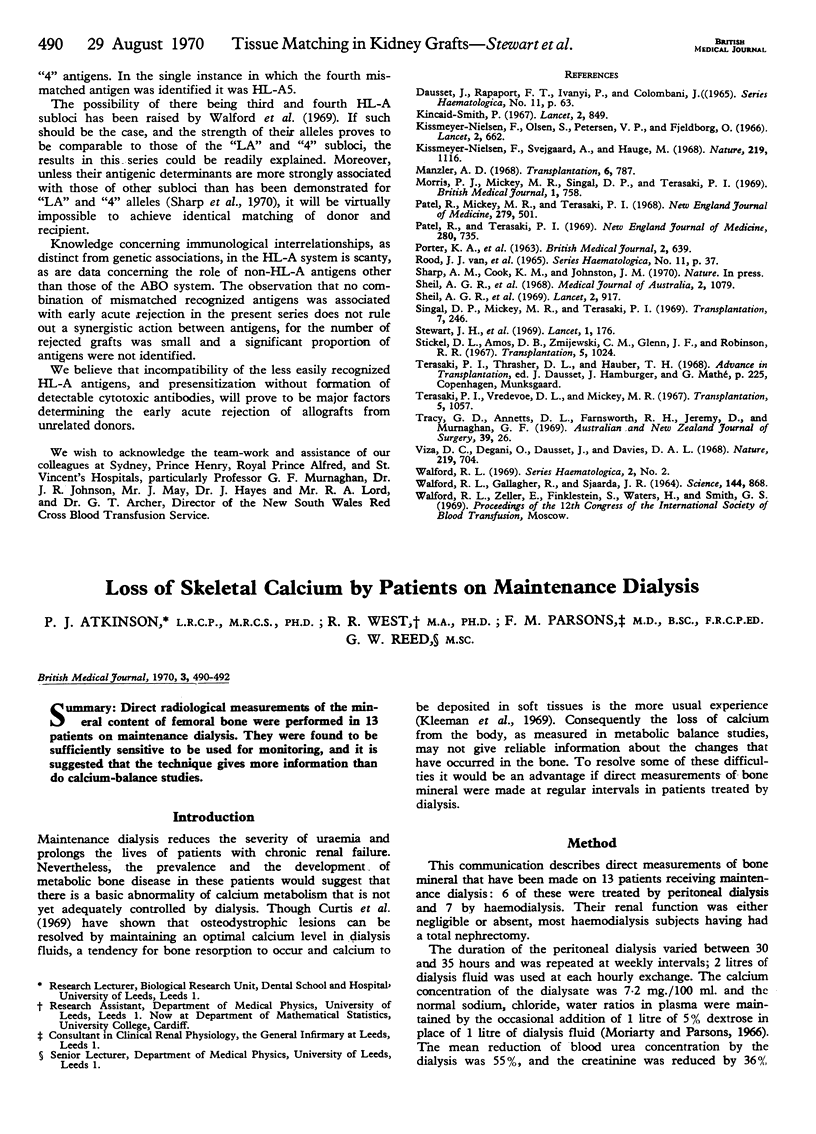Abstract
Tissue typing has been reviewed in a series of 100 technically successful cadaveric-donor kidney grafts. The criterion of transplant failure was immunological rejection causing total loss of function within three months of operation.
No significant correlation was observed between matching grade and graft failure due to early acute rejection. This is attributed to the failure to detect at least one “LA” or “4” antigen (as defined in our laboratory), representing a potential incompatibility, in 89% of the grafts, and in the remaining 11% to the lack of an available recipient with identical “LA” and “4” typing. Undetected antigens on the donor are usually incompatible, and probably these incompatibilities unfavourably influence early graft survival.
If the results of cadaveric-donor renal transplantation are to equal those of transplantation from well-matched living related donors it will be necessary to type with sera which can recognize individually all HL-A antigens, including those not yet identified, and to create an international pool of over 1,000 potential recipients.
Full text
PDF



Selected References
These references are in PubMed. This may not be the complete list of references from this article.
- Kincaid-Smith P. Histological diagnosis of rejection of renal homografts in man. Lancet. 1967 Oct 21;2(7521):849–852. doi: 10.1016/s0140-6736(67)92589-5. [DOI] [PubMed] [Google Scholar]
- Kissmeyer-Nielsen F., Olsen S., Petersen V. P., Fjeldborg O. Hyperacute rejection of kidney allografts, associated with pre-existing humoral antibodies against donor cells. Lancet. 1966 Sep 24;2(7465):662–665. doi: 10.1016/s0140-6736(66)92829-7. [DOI] [PubMed] [Google Scholar]
- Kissmeyer-Nielsen F., Svejgaard A., Hauge M. Genetics of the human HL-A transplantation system. Nature. 1968 Sep 14;219(5159):1116–1119. doi: 10.1038/2191116a0. [DOI] [PubMed] [Google Scholar]
- Manzler A. D. Serum cytotoxin in human kidney transplant recipients. Transplantation. 1968 Sep;6(6):787–792. doi: 10.1097/00007890-196809000-00006. [DOI] [PubMed] [Google Scholar]
- Morris P. J., Mickey M. R., Singal D. P., Terasaki P. I. Serotyping for homotransplantation. XXII. Specificity of cytotoxic antibodies developing after renal transplantation. Br Med J. 1969 Mar 22;1(5646):758–759. doi: 10.1136/bmj.1.5646.758. [DOI] [PMC free article] [PubMed] [Google Scholar]
- PORTER K. A., THOMSON W. B., OWEN K., KENYON J. R., MOWBRAY J. F., PEART W. S. OBLITERATIVE VASCULAR CHANGES IN FOUR HUMAN KIDNEY HOMOTRANSPLANTS. Br Med J. 1963 Sep 14;2(5358):639–645. doi: 10.1136/bmj.2.5358.639. [DOI] [PMC free article] [PubMed] [Google Scholar]
- Patel R., Mickey M. R., Terasaki P. I. Serotyping for homotransplantation. XVI. Analysis of kidney transplants from unrelated donors. N Engl J Med. 1968 Sep 5;279(10):501–506. doi: 10.1056/NEJM196809052791001. [DOI] [PubMed] [Google Scholar]
- Patel R., Terasaki P. I. Significance of the positive crossmatch test in kidney transplantation. N Engl J Med. 1969 Apr 3;280(14):735–739. doi: 10.1056/NEJM196904032801401. [DOI] [PubMed] [Google Scholar]
- Sheil A. G., Stewart J. H., Johnson J. R., May J., Storey B. G., Rogers J. H., Charlesworth J. A., Wright R., Sharp A., Johnston J. M. Community treatment of end-stage renal failure by dialysis and renal transplantation from cadaver donors. Lancet. 1969 Nov 1;2(7627):917–920. doi: 10.1016/s0140-6736(69)90586-8. [DOI] [PubMed] [Google Scholar]
- Sheil A. G., Stewart J. H., May J., Johnson J., Tiller D., George C. R., Rogers J. H., Storey B. G., Mani M. K., Gibson G. R. Renal transplantation from cadaver donors. Med J Aust. 1968 Dec 14;2(24):1079–1083. doi: 10.5694/j.1326-5377.1968.tb83432.x. [DOI] [PubMed] [Google Scholar]
- Singal D. P., Mickey M. R., Terasaki P. I. Serotyping for homotransplantation. 23. Analysis of kidney transplants from parental versus sibling donors. Transplantation. 1969 Apr;7(4):246–258. [PubMed] [Google Scholar]
- Stewart J. H., Sheil A. G., Johnson J. R., Wyatt K. M., Sharp A. M., Johnston J. M. Successful renal allotransplantation in presence of lymphocytotoxic antibodies. Importance of preoperative cross-matching. Lancet. 1969 Jan 25;1(7587):176–178. doi: 10.1016/s0140-6736(69)91190-8. [DOI] [PubMed] [Google Scholar]
- Stickel D. L., Amos D. B., Zmijewski C. M., Glenn J. F., Robinson R. R. Human renal transplantation with donor selection by leukocyte typing. Transplantation. 1967 Jul;5(4 Suppl):1024–1029. [PubMed] [Google Scholar]
- Terasaki P. I., Vredevoe D. L., Mickey M. R. Serotyping for homotransplantation. X. Survival of 196 grafted kidneys subsequent to typing. Transplantation. 1967 Jul;5(4 Suppl):1057–1070. doi: 10.1097/00007890-196707001-00041. [DOI] [PubMed] [Google Scholar]
- Tracy G. D., Annetts D. L., Farnsworth R. H., Jeremy D., Murnaghan G. F. The influence of technical factors upon renal homograft function. Aust N Z J Surg. 1969 Aug;39(1):26–30. doi: 10.1111/j.1445-2197.1969.tb05552.x. [DOI] [PubMed] [Google Scholar]
- Viza D. C., Degani O., Dausset J., Davies D. A. Lymphocyte stimulation by soluble human HL-A transplantation antigens. Nature. 1968 Aug 17;219(5155):704–706. doi: 10.1038/219704a0. [DOI] [PubMed] [Google Scholar]
- WALFORD R. L., GALLAGHER R., SJAARDA J. R. SEROLOGIC TYPING OF HUMAN LYMPHOCYTES WITH IMMUNE SERUM OBTAINED AFTER HOMOGRAFTING. Science. 1964 May 15;144(3620):868–870. doi: 10.1126/science.144.3620.868. [DOI] [PubMed] [Google Scholar]


